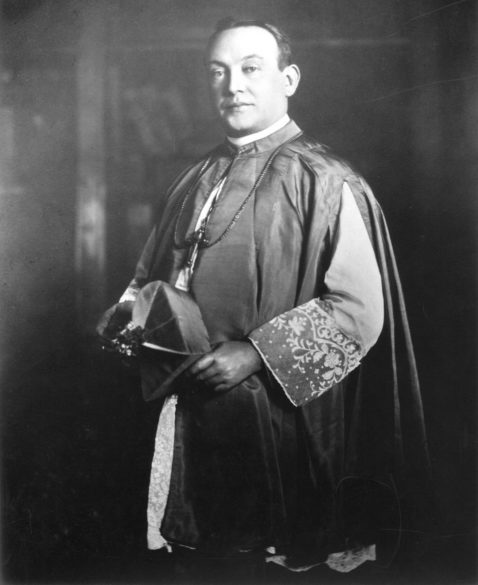From the Archives
By Mary Woodward
JACKSON – Very early on in his tenure as the fifth Bishop of Natchez, we almost lost Bishop John Edward Gunn to the Archdiocese of Wellington in New Zealand. It seems Bishop Gunn, a Marist, was summoned to New Orleans by Archbishop James Blenk to meet with him and Archbishop Francis Redwood of Wellington.
Bishop Gunn’s description of the meeting is classic Gunn so I will share the encounter in his own words from his diary:
“November 9, 1912 – I phoned the Archbishop early Saturday morning and he told me that Archbishop Redwood from New Zealand was with him and wanted to see me. I reported for dinner at Esplanade Avenue and I found Archbishop Redwood bubbling over with vitality, good health and splendid stories.
“When we left the dining room Redwood asked me to come with him to his room for a minute and then I found why I was wanted.

“It seems the Archbishop of Wellington wanted a co-adjutor and he wanted me for the job. He was so cocksure of getting me that he arranged everything in advance. He had a meeting of the suffragan bishops of New Zealand who ok’d the scheme; he got the Propaganda [of the Faith] in Rome to grant me a release from Natchez, if I was a consenting party; he asked the General of the Marists to write to me that I would be persona grata to the Society in New Zealand.
“The Archbishop forgot nothing that could be looked upon as a preliminary move and he followed very strictly the canonical requirements and I was summoned to say ‘Yes.’
“The Archbishop spoke of the advantages of New Zealand and my fitness for the work and incidentally deplored the fact that I was buried in Mississippi. He put up a good case and then he put the whole case up to me.
“I was dumbfounded and to a certain extent disgusted that I was being used as a kind of rubber pad with no voice in the matter whatever.
“In answer to the straight questions which he made in the matter of the Holy See and of the Bishops of New Zealand, etc., etc., I answered very shortly by saying ‘No’ to all he asked. He looked surprised and asked me if I did not want time to reconsider and I told him I did not.
“In a kind of perfunctory manner he asked me why I did not go and I simply told him that I would not use Mississippi or the Bishops of the Province, especially the Archbishop who had made me Bishop of Natchez, as a stepping stone to go anywhere and that I was satisfied where I was placed and I would not consent to any transfer of the kind.
“The Archbishop who was so amiable up to then was near losing his temper and I took the occasion to get away from him. He merely asked me to keep quiet about the interview until a co-adjutor for Wellington had been appointed.
“I went to Blenk’s room and I looked as if I had seen a ghost and the Archbishop insisted upon knowing what was the matter. I did not think that I was bound to keep such a secret from my Archbishop and I told him the whole story and I had the consolation of hearing from him that I had done the right thing.
“I cleared out of Esplanade Avenue and went over to Algiers where I spent the night and tried to forget about Wellington and its temptations. A few days after the incident I got a letter from the Superior General [Marist] asking me to go to Wellington but I had taken my stand, the die was cast and no power except the power that sent me to Mississippi could send me out of it.”
It is inspiring to see the commitment of Bishop Gunn to our diocese. I also found interesting the way Archbishop Redwood covered all avenues prior to asking Gunn to come to Wellington as co-adjutor.
Incidentally, Archbishop Redwood got his co-adjutor shortly after the Gunn refusal. Father Thomas O’Shea, a native of New Zealand and also a Marist, was consecrated as co-adjutor on Aug. 17, 1913. He remained co-adjutor until Redwood’s death in 1935 when he was installed as Archbishop of Wellington.
The process for selecting bishops nowadays is more process related with bishops submitting names to the papal nuncio of the country. Our current nuncio is Cardinal Christoph Pierre. The nuncio would then submit a preferred list of three to the Dicastery of Bishops in Rome. The Dicastery selects a candidate and presents the choice to the Holy Father. If the Holy Father approves the choice, then the candidate is contacted by the nuncio who relays that he has been appointed as bishop of a diocese.
And yes, some candidates say “No.” If this happens then the process starts over again. God bless Bishop Gunn for saying yes to the Spirit and coming to Mississippi.
(Mary Woodward is Chancellor and Archivist for the Diocese of Jackson.)
